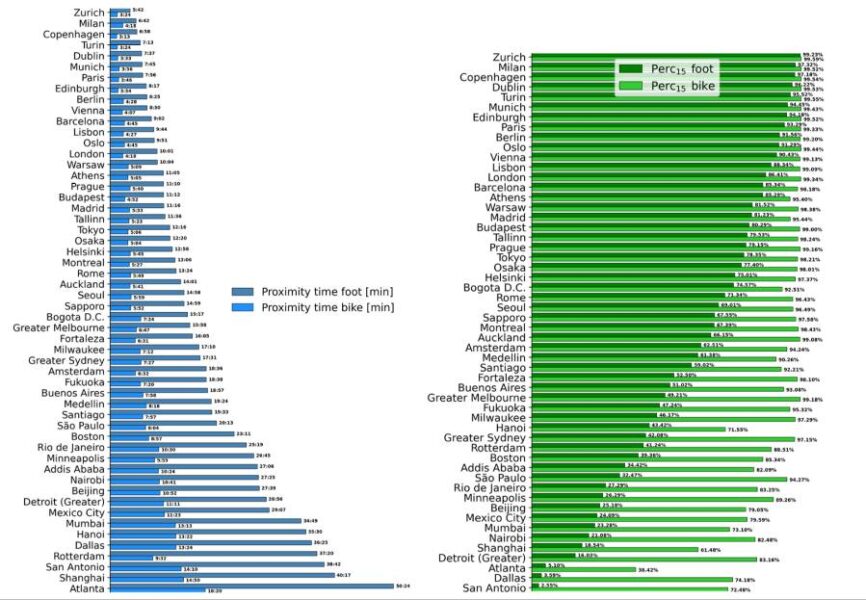Summary: New research reveals global inequalities in urban accessibility and proposes a shift from time-based to value-based city planning, challenging the universal applicability of the 15-minute city concept.
Estimated reading time: 6 minutes
The 15-minute city, an urban planning concept where essential services are within a 15-minute walk or bike ride, has gained traction as a solution to urban challenges. But a new study published in Nature Cities suggests this model may not be universally applicable, uncovering significant inequalities in urban accessibility worldwide.
Global City Scorecard: Who Makes the Cut?
Researchers, led by Vittorio Loreto from the Complexity Science Hub and Sapienza University of Rome, have developed a metric to quantify how close cities are to the 15-minute city ideal. Their findings paint a picture of stark contrasts.
“Our results revealed stark disparities in access to services, both within cities and between different regions, meaning that urban areas present a high level of inequality,” Loreto explains. This inequality manifests in various ways, including more expensive areas with better access to services.
On a global scale, European cities often score highly in accessibility, with Vienna cited as a prime example. However, most cities in the USA, Africa, and parts of Asia lag significantly behind, requiring much longer times to access basic services.
To make this data accessible, the team has created an open-access platform (whatif.sonycsl.it/15mincity) for exploring accessibility scores of cities worldwide.
Reimagining Urban Resources: The Relocation Algorithm
The study goes beyond identifying disparities. The researchers developed a “relocation algorithm” to simulate how redistributing existing resources and services could improve accessibility and reduce inequalities within cities.
This tool helps answer crucial questions: Does a neighborhood need massive transportation enhancements to reach essential services, or would a more distributed network of proximity services suffice?
The algorithm also simulates how cities would respond to an increase in services until they reach the 15-minute framework. Interestingly, the researchers observed considerable differences between cities in the minimum number of additional services required to fulfill the 15-minute city concept.
Even more striking is the finding that the very notion of a proximity-based city is not feasible in many cases. Loreto notes, “We observe that the very notion of a proximity-based city is not even conceivable in many cases, and a radically new paradigm has to be conceived.”
Beyond Time: The Value-Based City
The study concludes that a purely time-based ideal of a city is insufficient for creating livable urban spaces. Instead, the researchers propose a shift towards value-based cities, where local population densities, socio-economic factors, and cultural aspects are taken into account.
This approach recognizes that no two cities are alike, each requiring unique, tailored solutions to its complexities. The 15-minute city is just one of many frameworks that can help address urban challenges, but it may not be suitable for all contexts.
By utilizing such a model, urban planners, engineers, and policymakers can focus on creating customized solutions for their cities rather than applying one-size-fits-all approaches. This ensures cities become more accessible to a broader range of people, potentially leading to better access to healthcare, education, culture, and amenities.
As more than half of the world’s population now lives in cities—a figure that continues to grow—addressing these urban challenges becomes increasingly critical. The insights provided by this research offer a valuable tool for creating more equitable and livable cities in the future.
Glossary of Terms
- 15-minute city: An urban planning concept advocating that all city residents should be able to access essential services within a 15-minute walk or bike ride.
- Urban accessibility: The ease with which residents can reach essential services and amenities within a city.
- Relocation algorithm: A computational tool developed by the researchers to simulate the redistribution of resources and services within a city.
- Value-based cities: A proposed urban planning approach that considers local population densities, socio-economic factors, and cultural aspects, rather than focusing solely on time-based accessibility.
- Urban density: The number of people inhabiting a given urban area.
- Proximity services: Essential services located close to residential areas, reducing the need for long-distance travel.
- Open-access platform: A freely available online tool or resource that anyone can use without restrictions.
- Urban inequality: Disparities in access to resources, services, and opportunities within a city.
- Sustainable urban planning: City development strategies that aim to improve quality of life while minimizing environmental impact.
- Socio-economic factors: Social and economic elements that influence people’s lives and opportunities within a city.
Quiz: Test Your Knowledge on 15-Minute Cities
- According to the study, which region generally scored highly in terms of accessibility? a) USA b) Europe c) Africa d) Asia
- What tool did the researchers develop to simulate resource redistribution? a) Time-based algorithm b) Density calculator c) Relocation algorithm d) Urban sprawl index
- What new approach do the researchers suggest for city planning? a) Time-based cities b) Value-based cities c) Distance-based cities d) Population-based cities
Answers:
- b) Europe
- c) Relocation algorithm
- b) Value-based cities
Further Reading
- The Complexity Science Hub: Urban Systems Research
- United Nations Habitat: The New Urban Agenda
- World Health Organization: Urban Health
Enjoy this story? Get our newsletter! https://scienceblog.substack.com/


